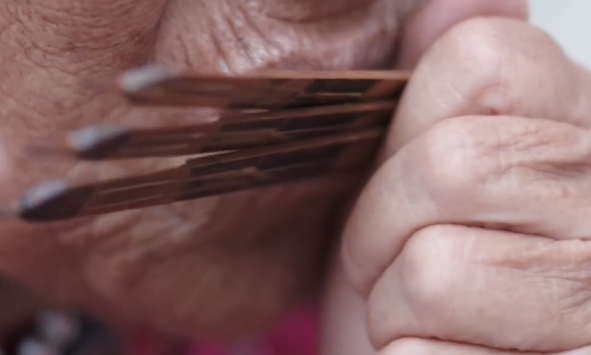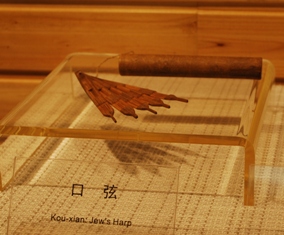The History of Bamboo Spring
215 views · Organized by 弥光 on 2022-02-09
Among ethnic minorities, Bamboo Spring has been inseparable from young people since ancient times. There are many legends about love associated with Bamboo Spring. There was a verse like this: "The one in my heart, we were born in the same place and live in the same place. A place, but it's so hard to meet each other! …”
It is said that in ancient times there was a young man and a woman who worked together in a rich man's house. They loved each other, but in feudal society, this kind of love was not allowed. They could not even speak a word. Passing on the love of love, the two fled to seek freedom. When their illusions were shattered, they used bamboo reeds to express their inner grief and jumped down the snowy mountain to die together.
In the long old society, there are too many tragedies like this. After the founding of New China, the world really changed. Whenever sunsets dotted the hills and fields were covered with twilight, the young men and women of the Yi nationality gathered after a day of hard work. Together, play the beloved bamboo reed, and confide in love to each other.
Because the sound of the bamboo reed is similar to the tone of the ethnic minorities, when it expresses thoughts and feelings, it can even express the artistic conception that is difficult to describe by poets. Sometimes, in order not to be heard by a third person, the bamboo reeds are whispered, and only lovers can understand the mystery.
Among the Yi people in Liangshan, there is a bamboo reed song "Ancient Trees Meet" played softly. The meaning of the words is: "There are as many words in my heart as stars. Let's talk through this bamboo reed. Tomorrow night, wait for the moon to climb up. When the time comes, gently close the door, and you will go under these two ancient trees. My dear, keep it in your heart, and then listen to the sound of my bamboo reeds."
During grand festivals such as "March Street" in Dali, young men and women of Bai nationality sing this bamboo reed song when they are in love: "Hang this bamboo reed on your chest, when you miss me, just take it Get it up and play a tune, as if we were meeting again."
Among the Naxi people, bamboo reeds have even become a condition for young people to choose their spouses. If the young man plays the bamboo reeds well, he may become the other party's favorite. Among the Jingpo and Miao nationalities, the bamboo reed is a special musical instrument for girls. When the quiet moonlit night comes, the girls always like to pluck the bamboo reed and share their heartfelt feelings with the Master.
The Lisu people living on both sides of the Nu River, young men and women often use bamboo springs to show their love. Bamboo springs are among the Gaoshan folks, and they are young people's partners in love and marriage proposals. Young men and women of the Li nationality like to use bamboo reeds to express their feelings for each other, and young men even use bamboo reeds as gifts for their girlfriends.
It is said that in ancient times there was a young man and a woman who worked together in a rich man's house. They loved each other, but in feudal society, this kind of love was not allowed. They could not even speak a word. Passing on the love of love, the two fled to seek freedom. When their illusions were shattered, they used bamboo reeds to express their inner grief and jumped down the snowy mountain to die together.
In the long old society, there are too many tragedies like this. After the founding of New China, the world really changed. Whenever sunsets dotted the hills and fields were covered with twilight, the young men and women of the Yi nationality gathered after a day of hard work. Together, play the beloved bamboo reed, and confide in love to each other.
Because the sound of the bamboo reed is similar to the tone of the ethnic minorities, when it expresses thoughts and feelings, it can even express the artistic conception that is difficult to describe by poets. Sometimes, in order not to be heard by a third person, the bamboo reeds are whispered, and only lovers can understand the mystery.
Among the Yi people in Liangshan, there is a bamboo reed song "Ancient Trees Meet" played softly. The meaning of the words is: "There are as many words in my heart as stars. Let's talk through this bamboo reed. Tomorrow night, wait for the moon to climb up. When the time comes, gently close the door, and you will go under these two ancient trees. My dear, keep it in your heart, and then listen to the sound of my bamboo reeds."

During grand festivals such as "March Street" in Dali, young men and women of Bai nationality sing this bamboo reed song when they are in love: "Hang this bamboo reed on your chest, when you miss me, just take it Get it up and play a tune, as if we were meeting again."
Among the Naxi people, bamboo reeds have even become a condition for young people to choose their spouses. If the young man plays the bamboo reeds well, he may become the other party's favorite. Among the Jingpo and Miao nationalities, the bamboo reed is a special musical instrument for girls. When the quiet moonlit night comes, the girls always like to pluck the bamboo reed and share their heartfelt feelings with the Master.

The Lisu people living on both sides of the Nu River, young men and women often use bamboo springs to show their love. Bamboo springs are among the Gaoshan folks, and they are young people's partners in love and marriage proposals. Young men and women of the Li nationality like to use bamboo reeds to express their feelings for each other, and young men even use bamboo reeds as gifts for their girlfriends.
Involving musical instruments
Bamboo spring (pinyin: zhú huáng) is also known as ringing bamboo, blowing bamboo, playing bamboo, mouth contempt, mouth spring, harmonica, mouth string. It has a long history and various forms. It is a comprehensive performance of Yi, Lahu, Naxi, Lisu, Dai, Hani, Jingpo, Wa, Brown, Nu, Dulong, Jinuo, Pumi, Miao, Tibetan, Lhoba, Qiang, Kazakh, Hui, Gaoshan, Li and Han nationalities in China. Body sounding instrument. It can play solo, unison, ensemble or accompany song and dance, and it occupies an important position in people's productive labor and daily life. Popular in Yunnan, Guizhou, Sichuan, Tibet, Xinjiang, Ningxia, Shaanxi, Guangxi, Guangdong, Taiwan, Hainan and other provinces.
Guess you like
Organized by 夜夜 on 2022-04-11
The "kouxian" of the Qiang nationality is a folk musical instrument invented by the women of the Qiang nationality when they rub the hemp rope while resting during the long-term production and labor.
read >>
Organized by 棠舟 on 2022-03-17
Today, the Lisu people living in Pingda Township, Longling County, Baoshan City, maintain their original culture from clothing to various customs. As an indispensable musical instrument in the history of the cultural development of the Lisu nationality, Sapin Magu has an ethereal and beautiful string sound that has been flying since ancient times.
read >>
Organized by 肖毅 on 2022-03-09
When the reporter participated in a cultural trip to the countryside held by the Yinchuan Federation of Literary and Art Circles in Haojiaqiao Town, Lingwu City, the reporter "ran into" Ma Yizhen, the inheritor of Ma's mouth strings, who performed at the event site. Applause.
read >>
Organized by 陌上花 on 2022-02-09
There are many beautiful legends about bamboo springs from all ethnic groups. In the Lahu cottage, there were two neighbors who lived on hunting in ancient times, and they got along very harmoniously.
read >>
 渝公网安备 50010702504639号
渝公网安备 50010702504639号